Analysis of Wage Determination Theories and Stakeholders
VerifiedAdded on 2020/05/01
|10
|1983
|60
Report
AI Summary
This report provides a detailed analysis of wage determination, focusing on the Fair Work Act and its implications. It examines various wage theories, including subsistence, standard of living, wage fund, residual claimant, marginal productivity, and discounted marginal productivity theories, critically evaluating their strengths and weaknesses. The report also explores the role of unions, specifically the Australian Council of Trade Union, in wage determination, advocating for workers' rights and improved working conditions. Furthermore, it delves into stakeholder approaches to reward management, discussing remuneration, compensation, and the motivation of employees through both intrinsic and extrinsic rewards. The conclusion emphasizes the significance of understanding wage determination theories for social researchers and the importance of promoting the standard of stakeholders, including the role of reward systems in motivating employees for the benefit of the company. The report uses references to support arguments.
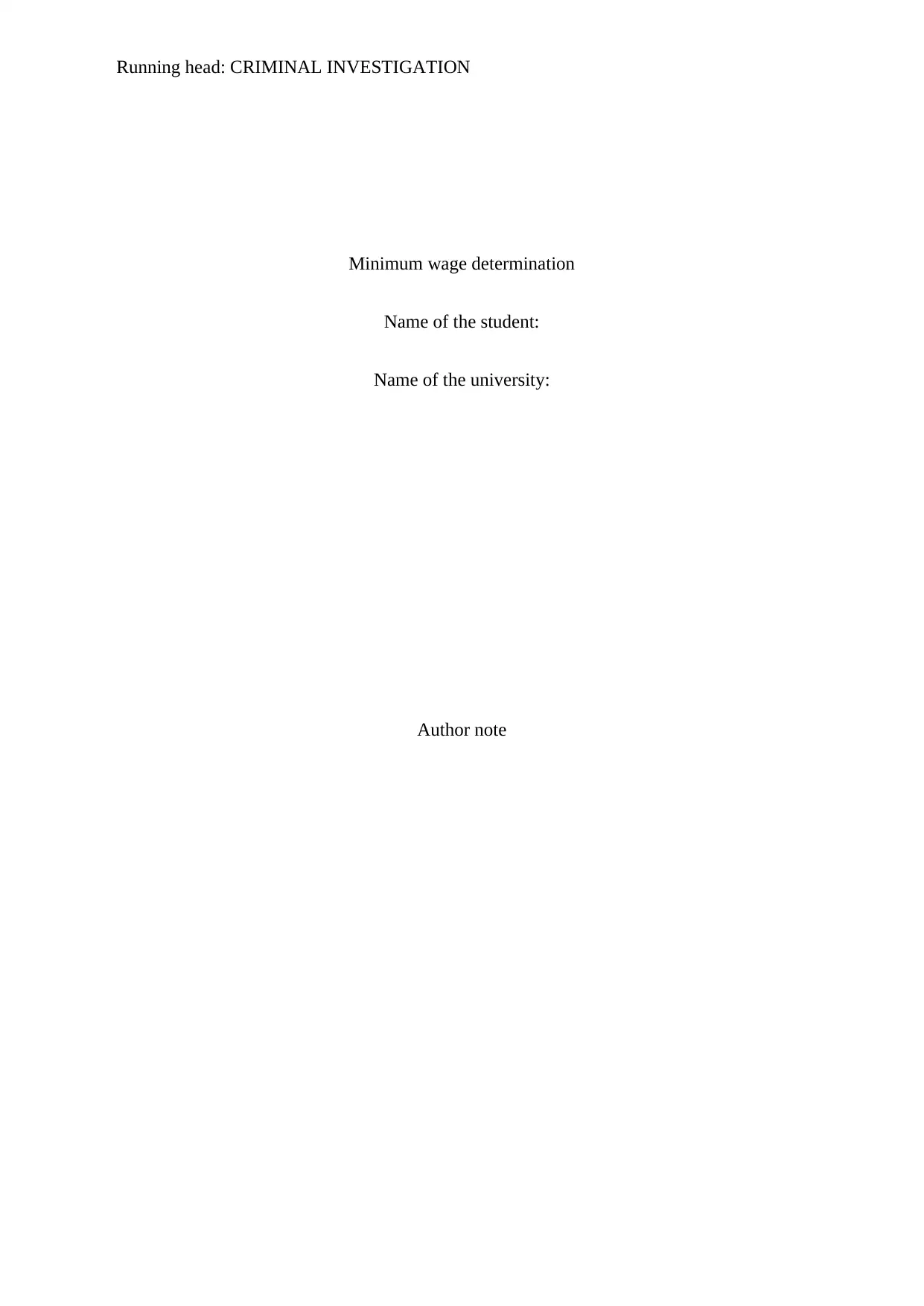
Running head: CRIMINAL INVESTIGATION
Minimum wage determination
Name of the student:
Name of the university:
Author note
Minimum wage determination
Name of the student:
Name of the university:
Author note
Paraphrase This Document
Need a fresh take? Get an instant paraphrase of this document with our AI Paraphraser
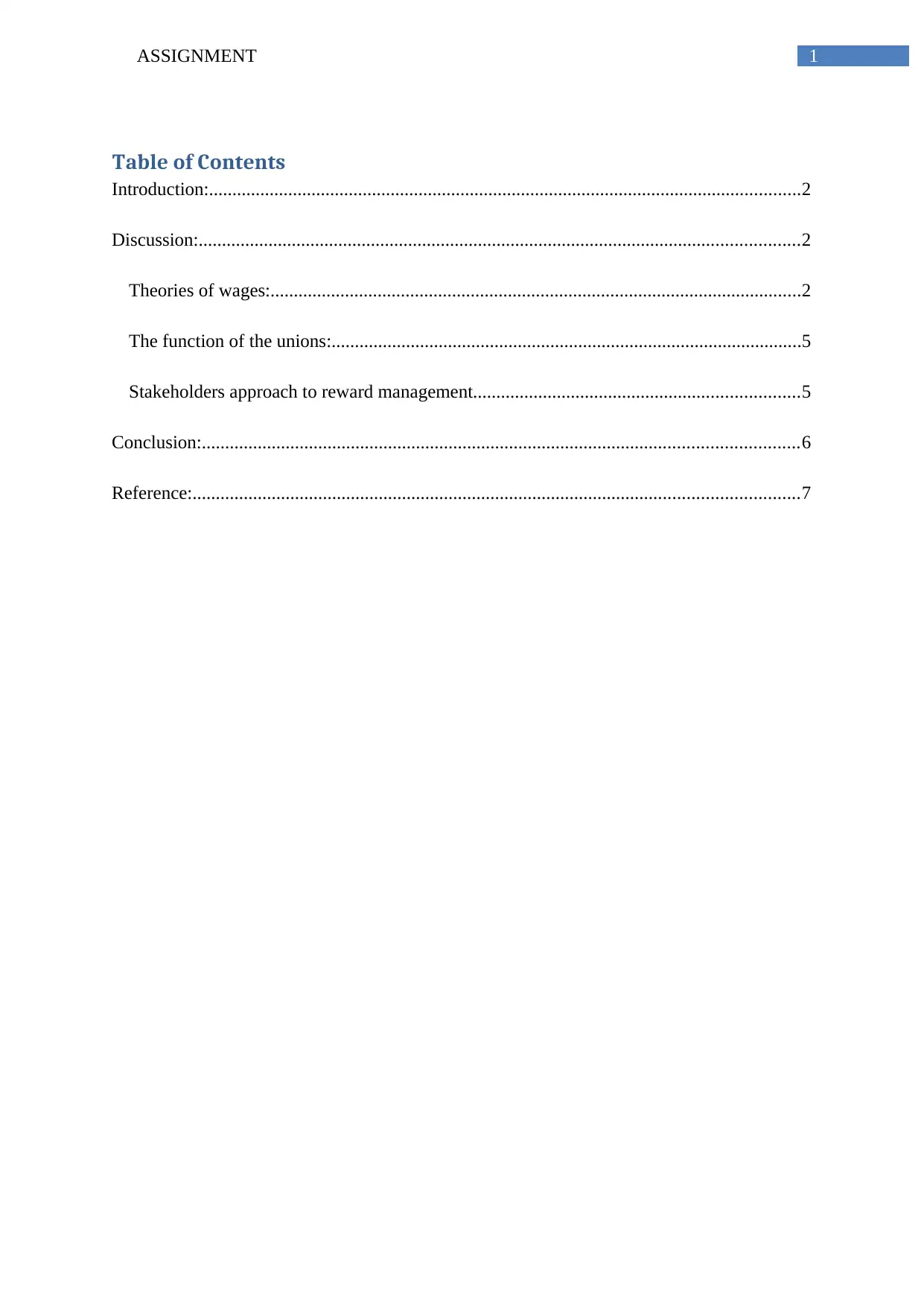
1ASSIGNMENT
Table of Contents
Introduction:...............................................................................................................................2
Discussion:.................................................................................................................................2
Theories of wages:..................................................................................................................2
The function of the unions:.....................................................................................................5
Stakeholders approach to reward management......................................................................5
Conclusion:................................................................................................................................6
Reference:..................................................................................................................................7
Table of Contents
Introduction:...............................................................................................................................2
Discussion:.................................................................................................................................2
Theories of wages:..................................................................................................................2
The function of the unions:.....................................................................................................5
Stakeholders approach to reward management......................................................................5
Conclusion:................................................................................................................................6
Reference:..................................................................................................................................7
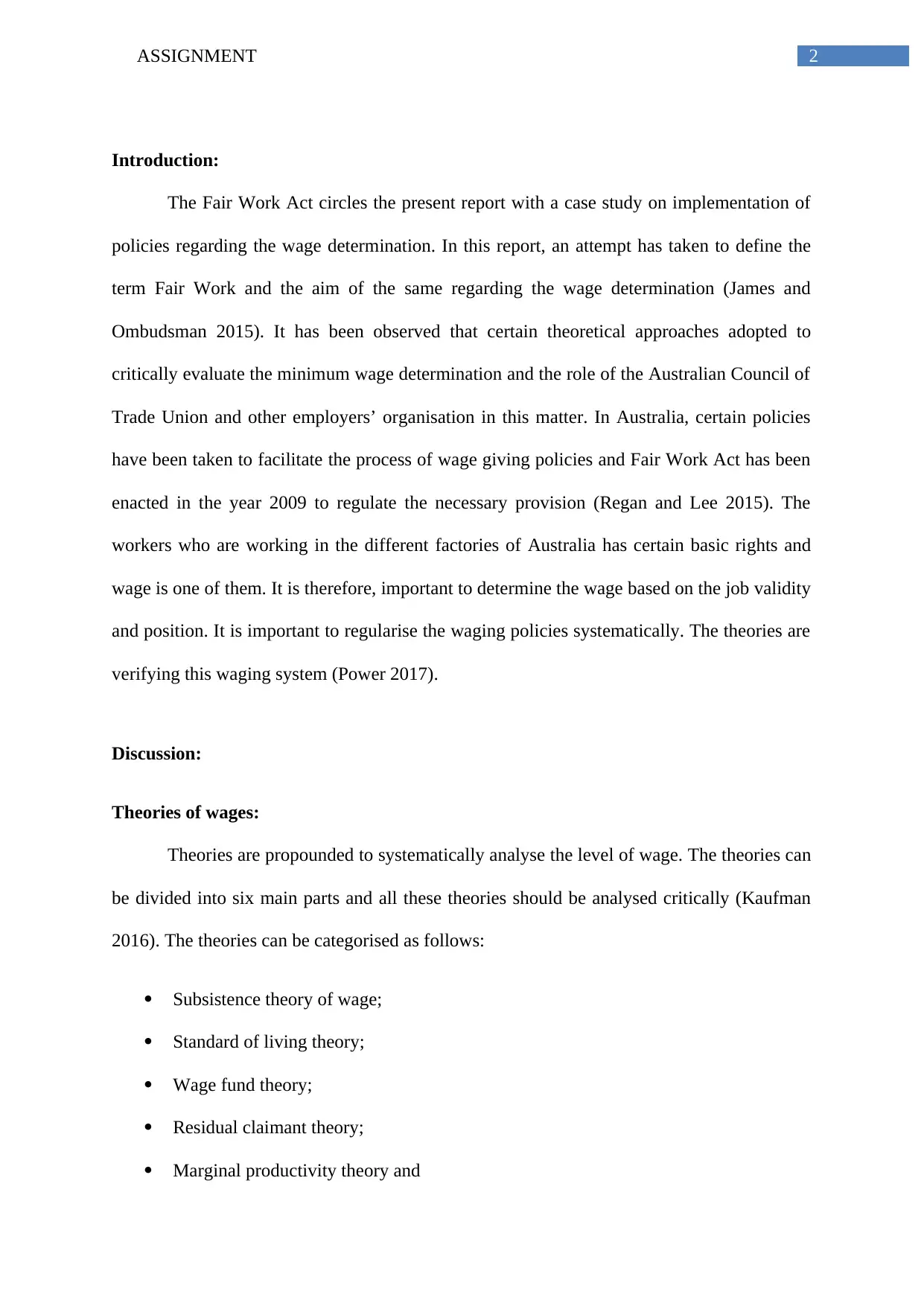
2ASSIGNMENT
Introduction:
The Fair Work Act circles the present report with a case study on implementation of
policies regarding the wage determination. In this report, an attempt has taken to define the
term Fair Work and the aim of the same regarding the wage determination (James and
Ombudsman 2015). It has been observed that certain theoretical approaches adopted to
critically evaluate the minimum wage determination and the role of the Australian Council of
Trade Union and other employers’ organisation in this matter. In Australia, certain policies
have been taken to facilitate the process of wage giving policies and Fair Work Act has been
enacted in the year 2009 to regulate the necessary provision (Regan and Lee 2015). The
workers who are working in the different factories of Australia has certain basic rights and
wage is one of them. It is therefore, important to determine the wage based on the job validity
and position. It is important to regularise the waging policies systematically. The theories are
verifying this waging system (Power 2017).
Discussion:
Theories of wages:
Theories are propounded to systematically analyse the level of wage. The theories can
be divided into six main parts and all these theories should be analysed critically (Kaufman
2016). The theories can be categorised as follows:
Subsistence theory of wage;
Standard of living theory;
Wage fund theory;
Residual claimant theory;
Marginal productivity theory and
Introduction:
The Fair Work Act circles the present report with a case study on implementation of
policies regarding the wage determination. In this report, an attempt has taken to define the
term Fair Work and the aim of the same regarding the wage determination (James and
Ombudsman 2015). It has been observed that certain theoretical approaches adopted to
critically evaluate the minimum wage determination and the role of the Australian Council of
Trade Union and other employers’ organisation in this matter. In Australia, certain policies
have been taken to facilitate the process of wage giving policies and Fair Work Act has been
enacted in the year 2009 to regulate the necessary provision (Regan and Lee 2015). The
workers who are working in the different factories of Australia has certain basic rights and
wage is one of them. It is therefore, important to determine the wage based on the job validity
and position. It is important to regularise the waging policies systematically. The theories are
verifying this waging system (Power 2017).
Discussion:
Theories of wages:
Theories are propounded to systematically analyse the level of wage. The theories can
be divided into six main parts and all these theories should be analysed critically (Kaufman
2016). The theories can be categorised as follows:
Subsistence theory of wage;
Standard of living theory;
Wage fund theory;
Residual claimant theory;
Marginal productivity theory and
⊘ This is a preview!⊘
Do you want full access?
Subscribe today to unlock all pages.

Trusted by 1+ million students worldwide
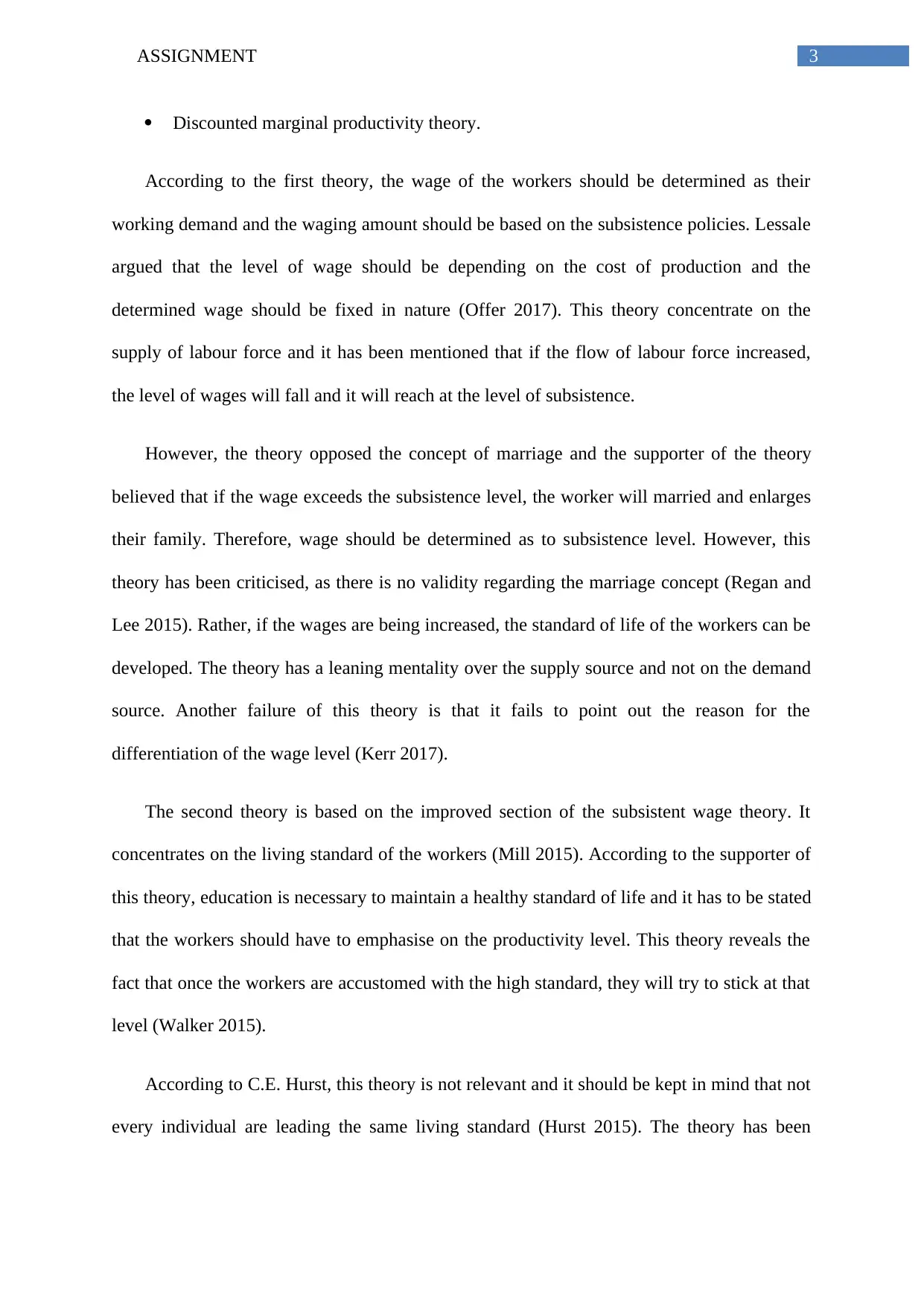
3ASSIGNMENT
Discounted marginal productivity theory.
According to the first theory, the wage of the workers should be determined as their
working demand and the waging amount should be based on the subsistence policies. Lessale
argued that the level of wage should be depending on the cost of production and the
determined wage should be fixed in nature (Offer 2017). This theory concentrate on the
supply of labour force and it has been mentioned that if the flow of labour force increased,
the level of wages will fall and it will reach at the level of subsistence.
However, the theory opposed the concept of marriage and the supporter of the theory
believed that if the wage exceeds the subsistence level, the worker will married and enlarges
their family. Therefore, wage should be determined as to subsistence level. However, this
theory has been criticised, as there is no validity regarding the marriage concept (Regan and
Lee 2015). Rather, if the wages are being increased, the standard of life of the workers can be
developed. The theory has a leaning mentality over the supply source and not on the demand
source. Another failure of this theory is that it fails to point out the reason for the
differentiation of the wage level (Kerr 2017).
The second theory is based on the improved section of the subsistent wage theory. It
concentrates on the living standard of the workers (Mill 2015). According to the supporter of
this theory, education is necessary to maintain a healthy standard of life and it has to be stated
that the workers should have to emphasise on the productivity level. This theory reveals the
fact that once the workers are accustomed with the high standard, they will try to stick at that
level (Walker 2015).
According to C.E. Hurst, this theory is not relevant and it should be kept in mind that not
every individual are leading the same living standard (Hurst 2015). The theory has been
Discounted marginal productivity theory.
According to the first theory, the wage of the workers should be determined as their
working demand and the waging amount should be based on the subsistence policies. Lessale
argued that the level of wage should be depending on the cost of production and the
determined wage should be fixed in nature (Offer 2017). This theory concentrate on the
supply of labour force and it has been mentioned that if the flow of labour force increased,
the level of wages will fall and it will reach at the level of subsistence.
However, the theory opposed the concept of marriage and the supporter of the theory
believed that if the wage exceeds the subsistence level, the worker will married and enlarges
their family. Therefore, wage should be determined as to subsistence level. However, this
theory has been criticised, as there is no validity regarding the marriage concept (Regan and
Lee 2015). Rather, if the wages are being increased, the standard of life of the workers can be
developed. The theory has a leaning mentality over the supply source and not on the demand
source. Another failure of this theory is that it fails to point out the reason for the
differentiation of the wage level (Kerr 2017).
The second theory is based on the improved section of the subsistent wage theory. It
concentrates on the living standard of the workers (Mill 2015). According to the supporter of
this theory, education is necessary to maintain a healthy standard of life and it has to be stated
that the workers should have to emphasise on the productivity level. This theory reveals the
fact that once the workers are accustomed with the high standard, they will try to stick at that
level (Walker 2015).
According to C.E. Hurst, this theory is not relevant and it should be kept in mind that not
every individual are leading the same living standard (Hurst 2015). The theory has been
Paraphrase This Document
Need a fresh take? Get an instant paraphrase of this document with our AI Paraphraser
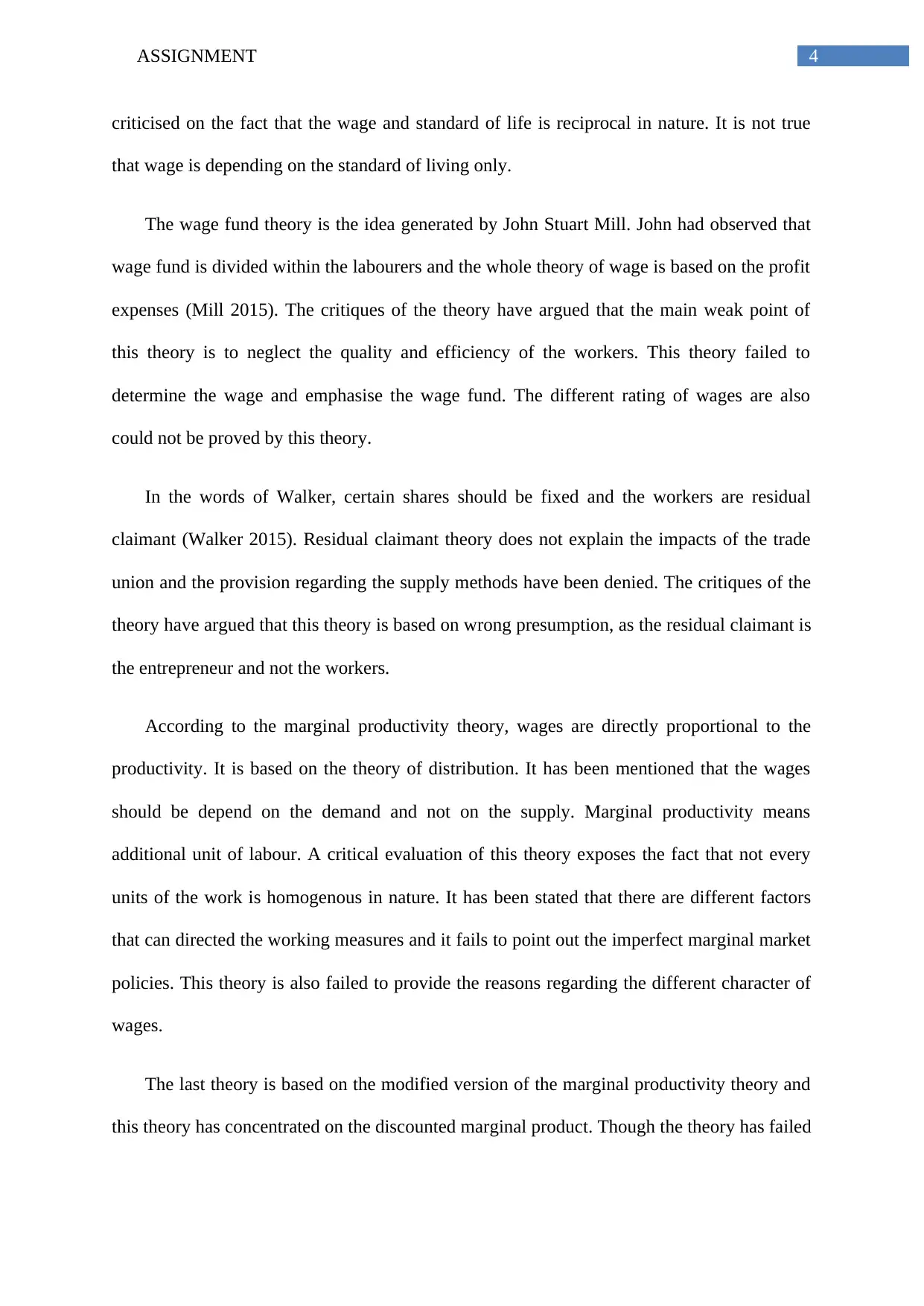
4ASSIGNMENT
criticised on the fact that the wage and standard of life is reciprocal in nature. It is not true
that wage is depending on the standard of living only.
The wage fund theory is the idea generated by John Stuart Mill. John had observed that
wage fund is divided within the labourers and the whole theory of wage is based on the profit
expenses (Mill 2015). The critiques of the theory have argued that the main weak point of
this theory is to neglect the quality and efficiency of the workers. This theory failed to
determine the wage and emphasise the wage fund. The different rating of wages are also
could not be proved by this theory.
In the words of Walker, certain shares should be fixed and the workers are residual
claimant (Walker 2015). Residual claimant theory does not explain the impacts of the trade
union and the provision regarding the supply methods have been denied. The critiques of the
theory have argued that this theory is based on wrong presumption, as the residual claimant is
the entrepreneur and not the workers.
According to the marginal productivity theory, wages are directly proportional to the
productivity. It is based on the theory of distribution. It has been mentioned that the wages
should be depend on the demand and not on the supply. Marginal productivity means
additional unit of labour. A critical evaluation of this theory exposes the fact that not every
units of the work is homogenous in nature. It has been stated that there are different factors
that can directed the working measures and it fails to point out the imperfect marginal market
policies. This theory is also failed to provide the reasons regarding the different character of
wages.
The last theory is based on the modified version of the marginal productivity theory and
this theory has concentrated on the discounted marginal product. Though the theory has failed
criticised on the fact that the wage and standard of life is reciprocal in nature. It is not true
that wage is depending on the standard of living only.
The wage fund theory is the idea generated by John Stuart Mill. John had observed that
wage fund is divided within the labourers and the whole theory of wage is based on the profit
expenses (Mill 2015). The critiques of the theory have argued that the main weak point of
this theory is to neglect the quality and efficiency of the workers. This theory failed to
determine the wage and emphasise the wage fund. The different rating of wages are also
could not be proved by this theory.
In the words of Walker, certain shares should be fixed and the workers are residual
claimant (Walker 2015). Residual claimant theory does not explain the impacts of the trade
union and the provision regarding the supply methods have been denied. The critiques of the
theory have argued that this theory is based on wrong presumption, as the residual claimant is
the entrepreneur and not the workers.
According to the marginal productivity theory, wages are directly proportional to the
productivity. It is based on the theory of distribution. It has been mentioned that the wages
should be depend on the demand and not on the supply. Marginal productivity means
additional unit of labour. A critical evaluation of this theory exposes the fact that not every
units of the work is homogenous in nature. It has been stated that there are different factors
that can directed the working measures and it fails to point out the imperfect marginal market
policies. This theory is also failed to provide the reasons regarding the different character of
wages.
The last theory is based on the modified version of the marginal productivity theory and
this theory has concentrated on the discounted marginal product. Though the theory has failed
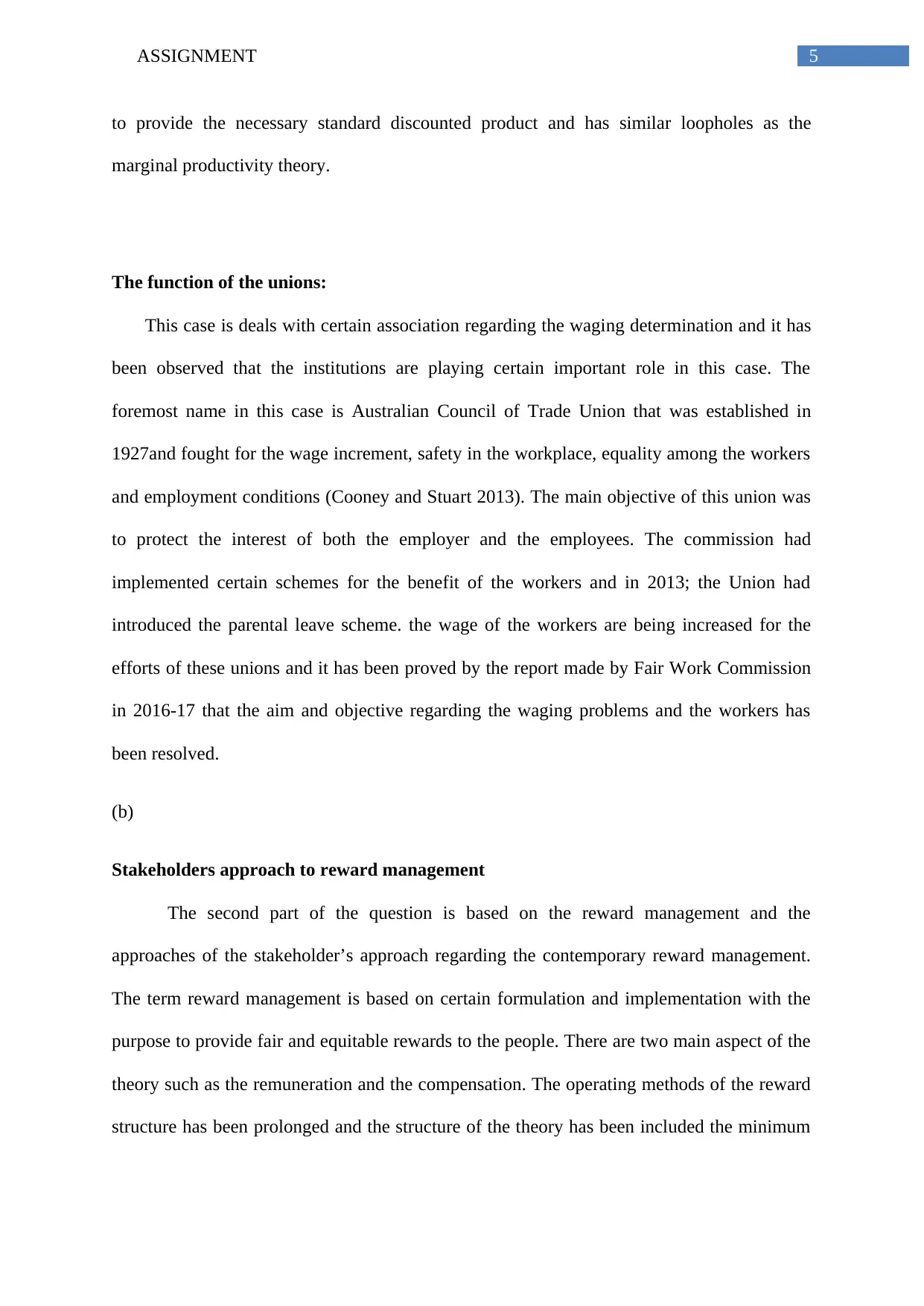
5ASSIGNMENT
to provide the necessary standard discounted product and has similar loopholes as the
marginal productivity theory.
The function of the unions:
This case is deals with certain association regarding the waging determination and it has
been observed that the institutions are playing certain important role in this case. The
foremost name in this case is Australian Council of Trade Union that was established in
1927and fought for the wage increment, safety in the workplace, equality among the workers
and employment conditions (Cooney and Stuart 2013). The main objective of this union was
to protect the interest of both the employer and the employees. The commission had
implemented certain schemes for the benefit of the workers and in 2013; the Union had
introduced the parental leave scheme. the wage of the workers are being increased for the
efforts of these unions and it has been proved by the report made by Fair Work Commission
in 2016-17 that the aim and objective regarding the waging problems and the workers has
been resolved.
(b)
Stakeholders approach to reward management
The second part of the question is based on the reward management and the
approaches of the stakeholder’s approach regarding the contemporary reward management.
The term reward management is based on certain formulation and implementation with the
purpose to provide fair and equitable rewards to the people. There are two main aspect of the
theory such as the remuneration and the compensation. The operating methods of the reward
structure has been prolonged and the structure of the theory has been included the minimum
to provide the necessary standard discounted product and has similar loopholes as the
marginal productivity theory.
The function of the unions:
This case is deals with certain association regarding the waging determination and it has
been observed that the institutions are playing certain important role in this case. The
foremost name in this case is Australian Council of Trade Union that was established in
1927and fought for the wage increment, safety in the workplace, equality among the workers
and employment conditions (Cooney and Stuart 2013). The main objective of this union was
to protect the interest of both the employer and the employees. The commission had
implemented certain schemes for the benefit of the workers and in 2013; the Union had
introduced the parental leave scheme. the wage of the workers are being increased for the
efforts of these unions and it has been proved by the report made by Fair Work Commission
in 2016-17 that the aim and objective regarding the waging problems and the workers has
been resolved.
(b)
Stakeholders approach to reward management
The second part of the question is based on the reward management and the
approaches of the stakeholder’s approach regarding the contemporary reward management.
The term reward management is based on certain formulation and implementation with the
purpose to provide fair and equitable rewards to the people. There are two main aspect of the
theory such as the remuneration and the compensation. The operating methods of the reward
structure has been prolonged and the structure of the theory has been included the minimum
⊘ This is a preview!⊘
Do you want full access?
Subscribe today to unlock all pages.

Trusted by 1+ million students worldwide

6ASSIGNMENT
waging system. Therefore, it can be stated that the reward management is contemporary to
the waging theories.
The main aim of the reward management and waging theories are to be chalked out.
The theory of reward management was intended to research on the behaviour of the workers
and all the processes and policies are to be managed in such way, which support the value of
the individuals. It motivates the employees so that they can engage them for the benefit of the
company and on the other hand, the company will be taken care for the employees to certain
extent. It has been mentioned by Kerr that the nature of the reward management is
changeable and hence it is important to maintain a standard form (Kerr 2017). The main
theme of the reward system is to motivate the employees and there are two parts of the
system- intrinsic and extrinsic motivations. Bonus, salary increment, gifts, promotions are the
example of the extrinsic reward, whereas feedback, recognitions are the instances of the
intrinsic motivations.
Therefore, it can be observed that all the policies regarding the reward management
are intend to motivate the stakeholders or the employers and the employees. These reward
management techniques, to certain extent help the stakeholders to motivate and they engaged
them for the beneficial interest of the company.
Conclusion:
The report can be concluded with the facts that the waging theories regarding the
wage determination help to understand the mentality of the social researchers and their
thinking over the wage system and the critical analysis of these theories help to identify the
loopholes of the system regarding the wage process (Card and Krueger 2015). It has to be
taken into consideration that stakeholders are the main subject of these theories and the motto
of the theories as well as the waging system is to promote the standard of the stakeholders.
waging system. Therefore, it can be stated that the reward management is contemporary to
the waging theories.
The main aim of the reward management and waging theories are to be chalked out.
The theory of reward management was intended to research on the behaviour of the workers
and all the processes and policies are to be managed in such way, which support the value of
the individuals. It motivates the employees so that they can engage them for the benefit of the
company and on the other hand, the company will be taken care for the employees to certain
extent. It has been mentioned by Kerr that the nature of the reward management is
changeable and hence it is important to maintain a standard form (Kerr 2017). The main
theme of the reward system is to motivate the employees and there are two parts of the
system- intrinsic and extrinsic motivations. Bonus, salary increment, gifts, promotions are the
example of the extrinsic reward, whereas feedback, recognitions are the instances of the
intrinsic motivations.
Therefore, it can be observed that all the policies regarding the reward management
are intend to motivate the stakeholders or the employers and the employees. These reward
management techniques, to certain extent help the stakeholders to motivate and they engaged
them for the beneficial interest of the company.
Conclusion:
The report can be concluded with the facts that the waging theories regarding the
wage determination help to understand the mentality of the social researchers and their
thinking over the wage system and the critical analysis of these theories help to identify the
loopholes of the system regarding the wage process (Card and Krueger 2015). It has to be
taken into consideration that stakeholders are the main subject of these theories and the motto
of the theories as well as the waging system is to promote the standard of the stakeholders.
Paraphrase This Document
Need a fresh take? Get an instant paraphrase of this document with our AI Paraphraser
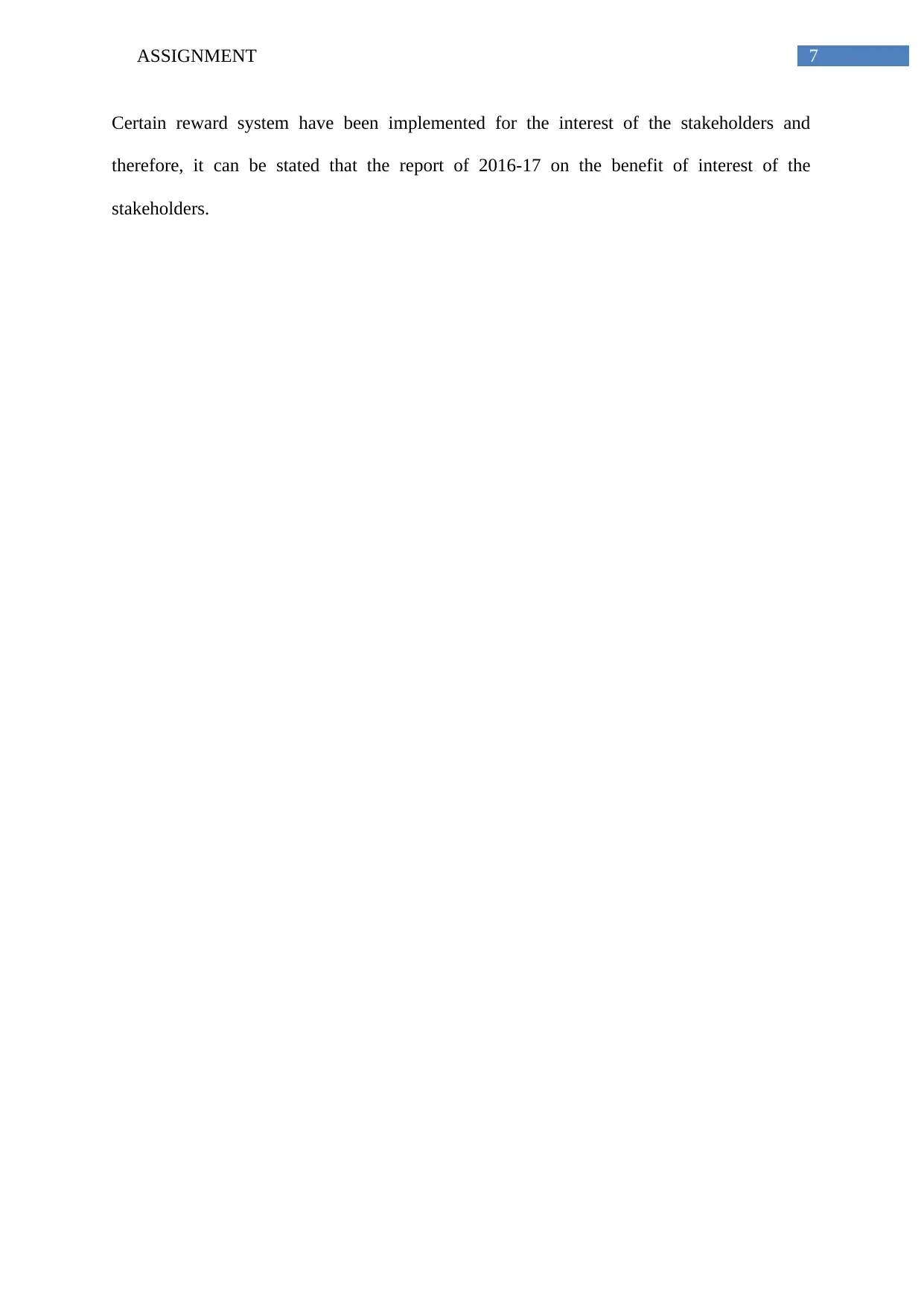
7ASSIGNMENT
Certain reward system have been implemented for the interest of the stakeholders and
therefore, it can be stated that the report of 2016-17 on the benefit of interest of the
stakeholders.
Certain reward system have been implemented for the interest of the stakeholders and
therefore, it can be stated that the report of 2016-17 on the benefit of interest of the
stakeholders.

8ASSIGNMENT
Reference:
Card, D. and Krueger, A.B., 2015. Myth and measurement: The new economics of the
minimum wage. Princeton University Press.
Cooney, R. and Stuart, M. eds., 2013. Trade unions and workplace training: Issues and
international perspectives. Routledge.
Dunlop, J. and Segrave, M., 2016. The theory of wage determination. Springer.
Hurst, C.E., 2015. Living theory: The application of classical social theory to contemporary
life. Routledge.
James, N., & Ombudsman, F. W. (2015). Commonwealth of Australia.
Kaufman, B.E., 2016. Adam Smith’s Economics and the Modern Minimum Wage Debate:
The Large Distance Separating Kirkcaldy from Chicago. Journal of Labor Research, 37(1),
pp.29-52.
Kerr, C., 2017. The effect of amenities on local wage distributions. Letters in Spatial and
Resource Sciences, 10(2), pp.215-228.
Mill, J.S., 2015. POST-GROWTH ECONOMICS. Prosperous Descent, p.29.
Offer, A., 2017. The market turn: from social democracy to market liberalism. The Economic
History Review.
Power, C., 2017. The Fair Work Commission's new approach. Governance Directions, 69(9),
p.540.
Regan, L. and Lee, C., 2015. Workplace law: Review of the fair work act: What will
change?. Proctor, The, 35(4), p.38.
Reference:
Card, D. and Krueger, A.B., 2015. Myth and measurement: The new economics of the
minimum wage. Princeton University Press.
Cooney, R. and Stuart, M. eds., 2013. Trade unions and workplace training: Issues and
international perspectives. Routledge.
Dunlop, J. and Segrave, M., 2016. The theory of wage determination. Springer.
Hurst, C.E., 2015. Living theory: The application of classical social theory to contemporary
life. Routledge.
James, N., & Ombudsman, F. W. (2015). Commonwealth of Australia.
Kaufman, B.E., 2016. Adam Smith’s Economics and the Modern Minimum Wage Debate:
The Large Distance Separating Kirkcaldy from Chicago. Journal of Labor Research, 37(1),
pp.29-52.
Kerr, C., 2017. The effect of amenities on local wage distributions. Letters in Spatial and
Resource Sciences, 10(2), pp.215-228.
Mill, J.S., 2015. POST-GROWTH ECONOMICS. Prosperous Descent, p.29.
Offer, A., 2017. The market turn: from social democracy to market liberalism. The Economic
History Review.
Power, C., 2017. The Fair Work Commission's new approach. Governance Directions, 69(9),
p.540.
Regan, L. and Lee, C., 2015. Workplace law: Review of the fair work act: What will
change?. Proctor, The, 35(4), p.38.
⊘ This is a preview!⊘
Do you want full access?
Subscribe today to unlock all pages.

Trusted by 1+ million students worldwide
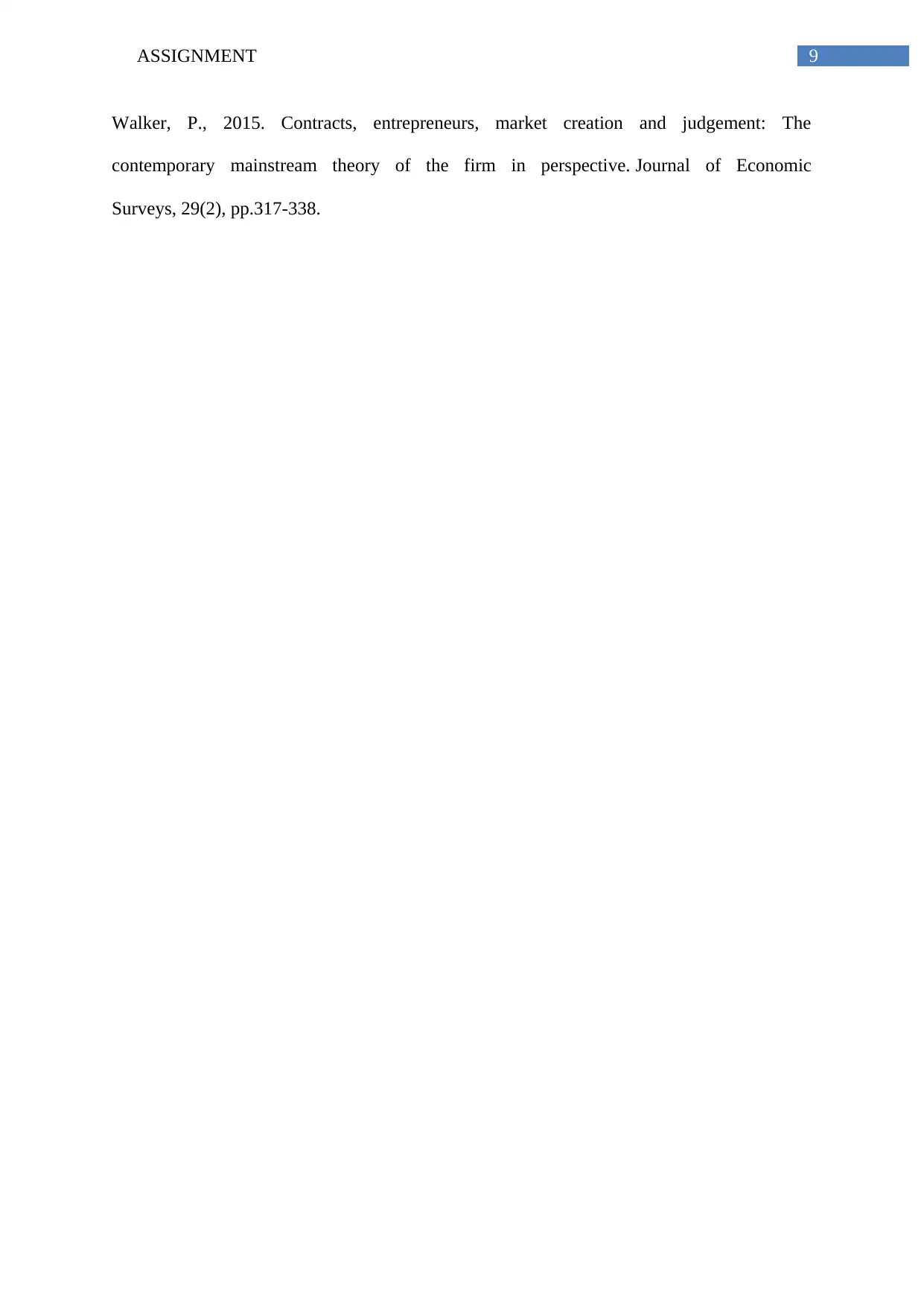
9ASSIGNMENT
Walker, P., 2015. Contracts, entrepreneurs, market creation and judgement: The
contemporary mainstream theory of the firm in perspective. Journal of Economic
Surveys, 29(2), pp.317-338.
Walker, P., 2015. Contracts, entrepreneurs, market creation and judgement: The
contemporary mainstream theory of the firm in perspective. Journal of Economic
Surveys, 29(2), pp.317-338.
1 out of 10
Related Documents
Your All-in-One AI-Powered Toolkit for Academic Success.
+13062052269
info@desklib.com
Available 24*7 on WhatsApp / Email
![[object Object]](/_next/static/media/star-bottom.7253800d.svg)
Unlock your academic potential
Copyright © 2020–2025 A2Z Services. All Rights Reserved. Developed and managed by ZUCOL.





